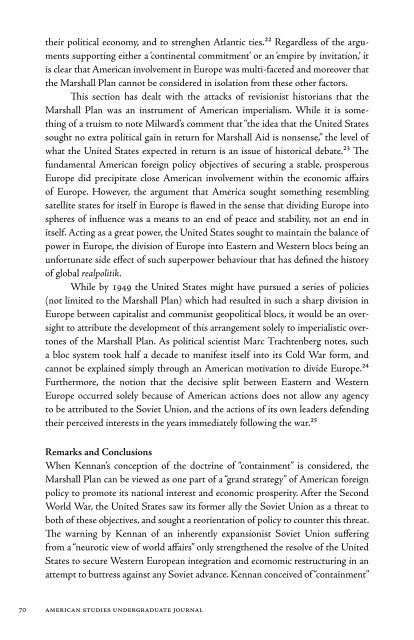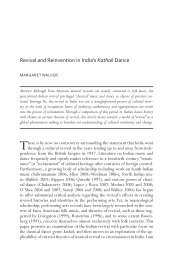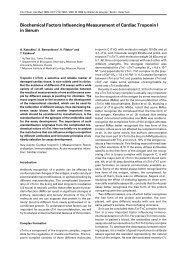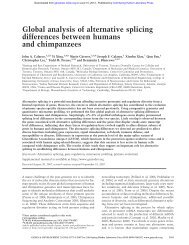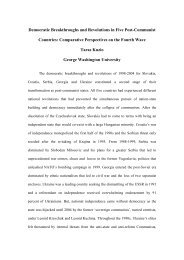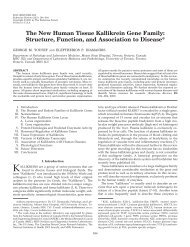AMERICAN STUDIES - University of Toronto
AMERICAN STUDIES - University of Toronto
AMERICAN STUDIES - University of Toronto
You also want an ePaper? Increase the reach of your titles
YUMPU automatically turns print PDFs into web optimized ePapers that Google loves.
their political economy, and to strenghen Atlantic ties.22 Regardless <strong>of</strong> the arguments<br />
supporting either a ‘continental commitment’ or an ‘empire by invitation,’ it<br />
is clear that American involvement in Europe was multi-faceted and moreover that<br />
the Marshall Plan cannot be considered in isolation from these other factors.<br />
This section has dealt with the attacks <strong>of</strong> revisionist historians that the<br />
Marshall Plan was an instrument <strong>of</strong> American imperialism. While it is something<br />
<strong>of</strong> a truism to note Milward’s comment that “the idea that the United States<br />
sought no extra political gain in return for Marshall Aid is nonsense,” the level <strong>of</strong><br />
what the United States expected in return is an issue <strong>of</strong> historical debate.23 The<br />
fundamental American foreign policy objectives <strong>of</strong> securing a stable, prosperous<br />
Europe did precipitate close American involvement within the economic affairs<br />
<strong>of</strong> Europe. However, the argument that America sought something resembling<br />
satellite states for itself in Europe is flawed in the sense that dividing Europe into<br />
spheres <strong>of</strong> influence was a means to an end <strong>of</strong> peace and stability, not an end in<br />
itself. Acting as a great power, the United States sought to maintain the balance <strong>of</strong><br />
power in Europe, the division <strong>of</strong> Europe into Eastern and Western blocs being an<br />
unfortunate side effect <strong>of</strong> such superpower behaviour that has defined the history<br />
<strong>of</strong> global realpolitik.<br />
While by 1949 the United States might have pursued a series <strong>of</strong> policies<br />
(not limited to the Marshall Plan) which had resulted in such a sharp division in<br />
Europe between capitalist and communist geopolitical blocs, it would be an oversight<br />
to attribute the development <strong>of</strong> this arrangement solely to imperialistic overtones<br />
<strong>of</strong> the Marshall Plan. As political scientist Marc Trachtenberg notes, such<br />
a bloc system took half a decade to manifest itself into its Cold War form, and<br />
cannot be explained simply through an American motivation to divide Europe.24<br />
Furthermore, the notion that the decisive split between Eastern and Western<br />
Europe occurred solely because <strong>of</strong> American actions does not allow any agency<br />
to be attributed to the Soviet Union, and the actions <strong>of</strong> its own leaders defending<br />
their perceived interests in the years immediately following the war.25<br />
Remarks and Conclusions<br />
When Kennan’s conception <strong>of</strong> the doctrine <strong>of</strong> “containment” is considered, the<br />
Marshall Plan can be viewed as one part <strong>of</strong> a “grand strategy” <strong>of</strong> American foreign<br />
policy to promote its national interest and economic prosperity. After the Second<br />
World War, the United States saw its former ally the Soviet Union as a threat to<br />
both <strong>of</strong> these objectives, and sought a reorientation <strong>of</strong> policy to counter this threat.<br />
The warning by Kennan <strong>of</strong> an inherently expansionist Soviet Union suffering<br />
from a “neurotic view <strong>of</strong> world affairs” only strengthened the resolve <strong>of</strong> the United<br />
States to secure Western European integration and ecomomic restructuring in an<br />
attempt to buttress against any Soviet advance. Kennan conceived <strong>of</strong> “containment”<br />
as being an “adroit and vigilant application <strong>of</strong> counterforce along a series <strong>of</strong> shifting<br />
geographical and political points.”26 In this respect, policymakers in Washington<br />
saw the implementation <strong>of</strong> the Marshall Plan as an economic application <strong>of</strong> counterforce.<br />
To this end, the purpose <strong>of</strong> American involvement in Europe was not an<br />
imperial project <strong>of</strong> forcing political and economic influence, but integral to a Cold<br />
War rhetoric and geopolitical strategic doctrine that demanded the United States<br />
keep Western Europe free from communism and respective Soviet power.<br />
This essay has sought to posit two interrelated claims: firstly, that the<br />
United States did conduct its foreign policy towards Europe under an “altruistic<br />
strain” towards the continent; and, secondly that the United States was successful<br />
in forming an “empire by invitation” in Western Europe. These claims have been<br />
explained with constant reference to the Marshall Plan, the policy that sought to<br />
reshape the post-war European economic climate to prevent the Soviet sphere <strong>of</strong><br />
influence stretching beyond its satellites in Eastern Europe.<br />
With reference to the assertion <strong>of</strong> an “altruistic strain,” American foreign<br />
policy objectives towards Europe in the immediate post-war world have been established.<br />
The Marshall Plan represented one instrument in the fight to contain communism,<br />
and protect the states <strong>of</strong> Western European from falling under its influence.<br />
The United States recognised the need for the security <strong>of</strong> Western Europe and<br />
to ensure its resurgence as an economic powerhouse. These objectives would be <strong>of</strong><br />
great benefit to the United States in consolidating its position as the most powerful<br />
nation on earth. Therefore, this unique position <strong>of</strong> the United States, coupled with<br />
the extraordinary benefits <strong>of</strong> pursuing a policy <strong>of</strong> economic assistance to Western<br />
Europe, allowed for a degree <strong>of</strong> altruism and goodwill in American foreign policy.<br />
The notion that the United States created an “empire by invitation” in<br />
Western Europe as a result <strong>of</strong> the Marshall Plan remains a contested issue. This<br />
revisionist approach to early Cold War history has come with many flaws, not least<br />
that it can paint American policy as the determining force <strong>of</strong> the events <strong>of</strong> 1945-<br />
49, rather than a factor informing the contested development <strong>of</strong> such events. It is<br />
difficult to rationalise the Soviet takeover <strong>of</strong> Eastern Europe, the Berlin Blockade,<br />
and the formation <strong>of</strong> Cominform, as being reducible to a reaction on the part <strong>of</strong><br />
the Soviet Union to counter an American imperialist agenda. It is important to<br />
acknowledge that both superpowers acted in an assertive, expansionist fashion<br />
that ensured the inevitable division <strong>of</strong> Europe by virtue <strong>of</strong> an Iron Curtain. By way<br />
<strong>of</strong> conclusion, the assertion <strong>of</strong> Cox and Kennedy-Pipe that the Marshall Plan was<br />
not “quite what it seemed,” and that it caused the division <strong>of</strong> Europe can be called<br />
into question.27 Ultimately, it is more appropriate to view the Marshall Plan as<br />
a pragmatic acknowledgement <strong>of</strong> divisions in Europe that were already taking<br />
place, and that the Marshall Plan drew attention to and modified these divisions<br />
rather than directly causing them.28<br />
70 American studies undergraduate journal American studies undergraduate journal 71


